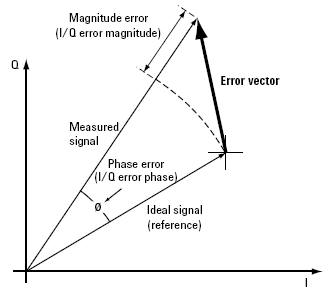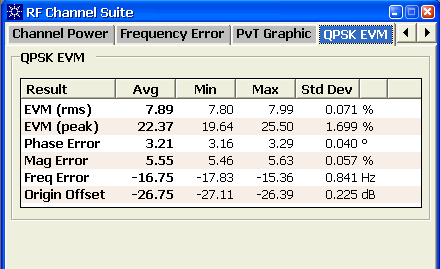
Last Updated: August 29, 2007
This topic describes the QPSK EVM measurement. QPSK EVM is a measurement in the RF Channel measurement suite.
This measurement allows you to measure a QPSK (quadrature phase-shift keying) modulated signal's error vector magnitude (EVM). This can be used to verify the performance of the wireless device's transmitter.
3GPP TS 34.121 section 5.13 states "The Error Vector Magnitude is a measure of the difference between the reference waveform and the measured waveform. This difference is called the error vector. Both waveforms pass through a matched Root Raised Cosine filter with bandwidth 3.84 MHz and roll-off alpha =0.22. Both waveforms are then further modified by selecting the frequency, absolute phase, absolute amplitude and chip clock timing so as to minimise the error vector. The EVM result is defined as the square root of the ratio of the mean error vector power to the mean reference power expressed as a %."
The EVM measurement in the test set compares the received signal's IQ modulation characteristics to an ideal signal, as defined in 3GPP TS 34.121 section 5.13 and annex B. As can be seen in the figure below, the error vector is the difference between the measured signal and reference signal.
Figure 1: Error Vector

The two main differences between this measurement and the WCDMA Error Vector Magnitude (EVM) Measurement, the cdma2000/1xEV-DO Waveform Quality Measurement and the TD-SCDMA Error Vector Magnitude (EVM) Measurement are:
that the signal typically measured on the WCDMA Error Vector Magnitude (EVM), cdma2000/1xEV-DO Waveform Quality and TD-SCDMA Error Vector Magnitude (EVM) measurements is a full waveform quality measurement and is made up of multiple code channels. However this measurement only allows a single code channel.
the WCDMA Error Vector Magnitude (EVM), cdma2000/1xEV-DO Waveform Quality and TD-SCDMA Error Vector Magnitude (EVM) measurements require a reference in the form of pilot bits or midamble to find the signal parameters (for example, frequency error). This measurement requires no reference (that is, chip pattern).
This measurement requires you to use the 5 MHz filter setting.
For more information refer to How are the Measurements in the RF Channel Measurement Suite Made?.
QPSK EVM is a measurement in the RF Channel measurement suite. See RF Channel Measurement Suite Setup Parameters for details of the parameters that apply to all measurements in the suite.
This result provides the integrity indicator for the RF Channel measurement suite. Normal indicates that the measurement suite completed successfully without error and the result is accurate. For details of other integrity indicators, see Measurement Integrity Indicator.
SCPI command: FETCh:RFCHannel:INTegrity?
This result provides the Error Vector Magnitude in % rms. If the Multi-Measurement Count is enabled, the average, minimum, maximum and standard deviation results are returned, otherwise the single measurement result is returned.
SCPI command: FETCh:RFCHannel:EVMQpsk[:PARTial]?, FETCh:RFCHannel:EVMQpsk:ALL?
This result provides the peak Error Vector Magnitude in %. If the Multi-Measurement Count is enabled, the average, minimum, maximum and standard deviation results are returned, otherwise the single measurement result is returned.
SCPI command: FETCh:RFCHannel:EVMQpsk[:PARTial]?, FETCh:RFCHannel:EVMQpsk:ALL?
This result provides the phase error in degrees. If the Multi-Measurement Count is enabled, the average, minimum, maximum and standard deviation results are returned, otherwise the single measurement result is returned.
SCPI command: FETCh:RFCHannel:EVMQpsk[:PARTial]?, FETCh:RFCHannel:EVMQpsk:ALL?
This result provides the magnitude error in %. If the Multi-Measurement Count is enabled, the average, minimum, maximum and standard deviation results are returned, otherwise the single measurement result is returned.
SCPI command: FETCh:RFCHannel:EVMQpsk[:PARTial]?, FETCh:RFCHannel:EVMQpsk:ALL?
This result provides the frequency error in Hz. If the Multi-Measurement Count is enabled, the average, minimum, maximum and standard deviation results are returned, otherwise the single measurement result is returned.
SCPI command: FETCh:RFCHannel:EVMQpsk[:PARTial]?, FETCh:RFCHannel:EVMQpsk:ALL?
This result provides the origin offset (distance away from the origin) in dB. If the Multi-Measurement Count is enabled, the average, minimum, maximum and standard deviation results are returned, otherwise the single measurement result is returned.
SCPI command: FETCh:RFCHannel:EVMQpsk[:PARTial]?, FETCh:RFCHannel:EVMQpsk:ALL?
The measurement results are available on the RF Channel Suite's QPSK EVM tab as shown below. (Note, to display the QPSK EVM tab, the measurement must be enabled in the RF Channel Suite Setup window's Results Configuration tab.)
These results are also displayed on the RF Channel Suite's Summary tab if the measurement is enabled.

QPSK EVM is a measurement in the RF Channel measurement suite. See RF Channel Input Signal Requirements for details of the input signal requirements that apply to all measurements in the suite.